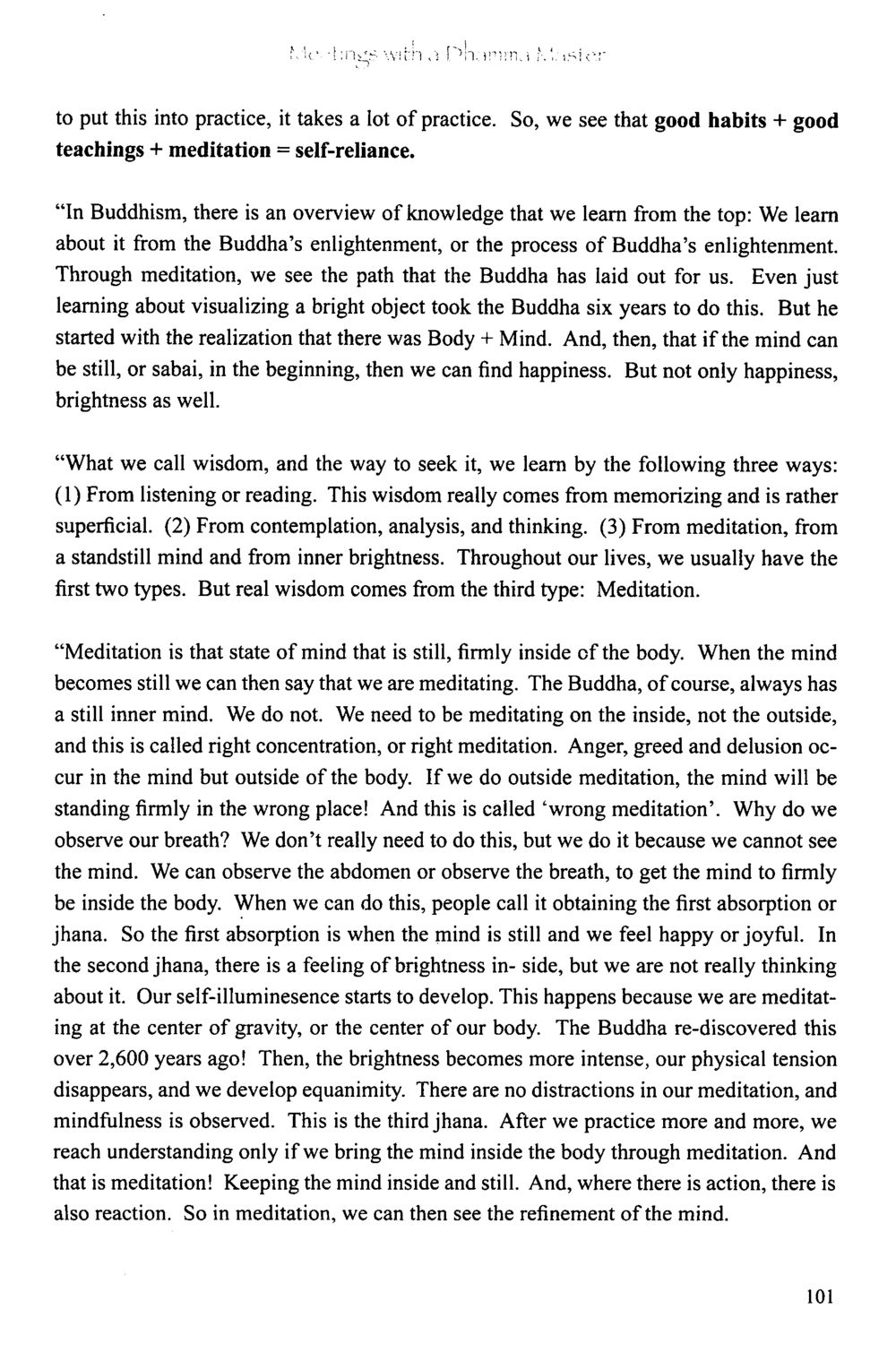The Path to Self-Reliance Through Meditation : หน้า 102/164
The Meeting with a Dhamma Master : หน้า 102/164 Discover how good habits, teachings, and meditation lead to self-reliance in Buddhism.
5 ครั้ง

สรุปเนื้อหา
บทความนี้นําเสนอวิธีการที่การปฏิบัติและสมาธิสามารถนํามาซึ่งการพึ่งพาตนเอง ตามแนวทางที่พระพุทธเจ้าได้วางไว้ การทำสมาธิช่วยให้จิตใจสงบ ช่วยให้เรากลับพบกับความสุขและความสดใสที่แท้จริง ด้วยการฝึกฝนและการมองเข้าไปข้างใน เราสามารถพัฒนาปัญญาผ่านสามวิธีคือการฟัง การพิจารณา และการทำสมาธิ โดยการฝึกสมาธิที่ถูกต้องเราจะสามารถเห็นการเปลี่ยนแปลงในจิตใจและลดความเครียดได้
หัวข้อประเด็น
-ปฏิบัติการเพื่อการพึ่งพาตนเอง
-การเรียนรู้จากธรรม
-มุมมองของพระพุทธเจ้า
-สมาธิและความสงบ
-การพัฒนาจิตใจ
ข้อความต้นฉบับในหน้า
to put this into practice, it takes a lot of practice. So, we see that **good habits + good teachings + meditation = self-reliance**.
"In Buddhism, there is an overview of knowledge that we learn from the top: We learn about it from the Buddha’s enlightenment, or the process of Buddha’s enlightenment. Through meditation, we see the path that the Buddha has laid out for us. Even just learning about visualizing a bright object took the Buddha six years to do this. But he started with the realization that **there was Body + Mind**. And, then, that if the mind can be still, or sabai, in the beginning, then we can find happiness. But not only happiness, brightness as well.
“What we call wisdom, and the way to seek it, we learn by the following three ways: (1) From listening or reading. This wisdom really comes from memorizing and is rather superficial. (2) From contemplation, analysis, and thinking. (3) From meditation, from a standstill mind and from inner brightness. Throughout our lives, we usually have the first two types. But real wisdom comes from the third type: Meditation.
“Meditation is that state of mind that is still, firmly inside of the body. When the mind becomes still we can then say that we are meditating. The Buddha, of course, always has a still inner mind. We do not. We need to be meditating on the inside, not the outside, and this is called right concentration, or right meditation. Anger, greed and delusion occur in the mind but outside of the body. If we do outside meditation, the mind will be standing firmly in the wrong place! And this is called ‘wrong meditation’. Why do we observe our breath? We don’t really need to do this, but we do it because we cannot see the mind. We can observe the abdomen or observe the breath, to get the mind to firmly be inside the body. When we can do this, people call it obtaining the first absorption or jhana. So the first absorption is when the mind is still and we feel happy or joyful. In the second jhana, there is a feeling of brightness in- side, but we are not really thinking about it. Our self-illuminance starts to develop. This happens because we are meditating at the center of gravity, or the center of our body. The Buddha re-discovered this over 2,600 years ago! Then, the brightness becomes more intense, our physical tension disappears, and we develop equanimity. There are no distractions in our meditation, and mindfulness is observed. This is the third jhana. After we practice more and more, we reach understanding only if we bring the mind inside the body through meditation. And that is meditation! Keeping the mind inside and still. And, where there is action, there is also reaction. So in meditation, we can then see the refinement of the mind.
หน้าหนังสือทั้งหมด

1

2

3

4

5

6

7

8

9

10

11

12

13

14

15

16

17

18

19

20

21

22

23

24

25

26

27

28

29

30

31

32

33

34

35

36

37

38

39

40

41

42

43

44

45

46

47

48

49

50

51

52

53

54

55

56

57

58

59

60

61

62

63

64

65

66

67

68

69

70

71

72

73

74

75

76

77

78

79

80

81

82

83

84

85

86

87

88

89

90

91

92

93

94

95

96

97

98

99

100

101

102

103

104

105

106

107

108

109

110

111

112

113

114

115

116

117

118

119

120

121

122

123

124

125

126

127

128

129

130

131

132

133

134

135

136

137

138

139

140

141

142

143

144

145

146

147

148

149

150

151

152

153

154

155

156

157

158

159

160

161

162

163

164
หนังสือที่เกี่ยวข้อง
Load More
